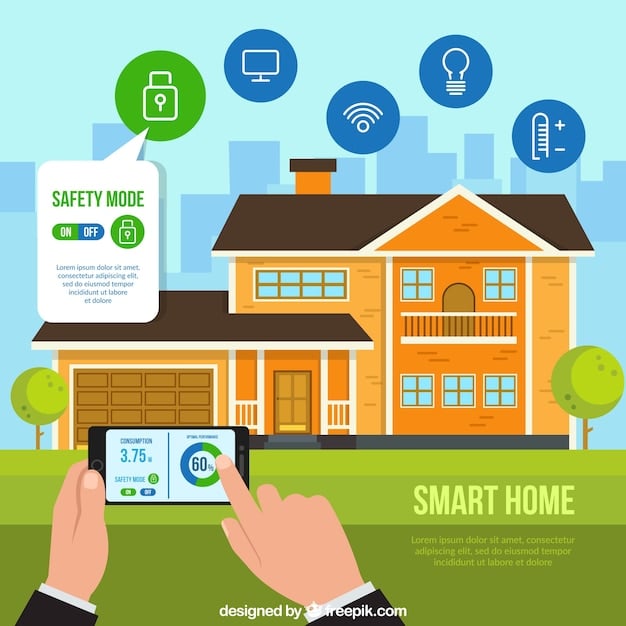Energy-Efficient Smart Homes: Will Incentives Drive 30% Adoption by 2026?

Energy-efficient smart homes could see a surge in adoption thanks to new federal incentives, potentially reaching 30% of households by 2026 through tax credits and rebates that make sustainable technology more accessible and affordable.
Can new federal incentives catalyze a 30% adoption rate for energy-efficient smart homes by 2026? Let’s explore the potential impact of government programs on sustainable living.
The Rise of Energy-Efficient Smart Homes
Smart home technology has evolved beyond mere convenience, now playing a vital role in energy conservation. Integrating smart devices with energy-efficient systems can significantly reduce household energy consumption, leading to lower utility bills and a smaller carbon footprint.
Several factors are driving the adoption of energy-efficient smart homes, including increasing environmental awareness, technological advancements, and cost savings. As consumers become more conscious of their impact on the planet, they are actively seeking ways to reduce their energy use and adopt sustainable practices. Smart home technology provides a tangible solution, offering real-time insights and automated controls to optimize energy consumption.

Key Components of Energy-Efficient Smart Homes
Smart homes achieve energy efficiency through various interconnected devices and systems. Let’s dive into some essential components that work together to create a sustainable living environment:
- Smart Thermostats: Learning thermostats automatically adjust temperature settings based on occupancy patterns and preferences, optimizing heating and cooling schedules to minimize energy waste.
- Smart Lighting: Smart lighting systems use energy-efficient LED bulbs and allow users to control lighting levels remotely, schedule on/off times, and even adjust lighting based on natural light availability.
- Smart Appliances: Energy-efficient smart appliances, such as refrigerators, washing machines, and dishwashers, optimize their operations to reduce energy consumption without compromising performance.
- Energy Monitoring Systems: These systems provide real-time data on energy usage, allowing homeowners to identify energy hogs and make informed decisions to reduce consumption.
The convergence of these technologies creates a comprehensive energy management system that empowers homeowners to take control of their energy usage and contribute to a more sustainable future.
In conclusion, energy-efficient smart homes represent a significant step towards sustainable living, offering a blend of convenience, cost savings, and environmental responsibility. The increasing awareness and availability of these technologies are setting the stage for a more energy-conscious society.
Understanding Federal Incentives for Smart Homes
The US government is increasingly recognizing the importance of energy efficiency in homes and is offering a range of incentives to encourage homeowners to adopt smart and sustainable technologies. These incentives aim to make energy-efficient upgrades more accessible and affordable, driving broader adoption across the nation.
These federal incentives come in different forms, including tax credits, rebates, and grant programs. They are designed to offset the upfront costs of purchasing and installing energy-efficient smart home devices and systems. By reducing the financial burden, the government aims to accelerate the transition towards a greener and more sustainable housing sector.
Types of Federal Incentives Available
Understanding the different types of incentives available is crucial for homeowners looking to leverage these opportunities. Here’s an overview of some common federal incentives:
- Tax Credits: Tax credits directly reduce the amount of taxes owed. For example, the Energy Efficient Home Improvement Credit allows homeowners to claim a percentage of the costs for qualified energy-efficient improvements, such as installing smart thermostats or energy-efficient windows.
- Rebates: Rebates offer a partial refund after the purchase and installation of qualified energy-efficient products. These rebates can be offered at the federal, state, or local level and can significantly reduce the initial investment in smart home technology.
- Grant Programs: Grant programs provide direct financial assistance for energy-efficient upgrades. These programs are often targeted towards low-income households and communities, ensuring that the benefits of energy efficiency are accessible to all.
Homeowners should research the specific incentives available in their area, as the eligibility criteria and the amount of the incentives can vary.

These incentives play a critical role in driving the adoption of energy-efficient smart homes by making sustainable technologies more affordable and accessible to a wider range of homeowners. The combined effect of these programs can significantly reduce the upfront costs, making energy-efficient upgrades a more attractive investment.
Potential Impact on Smart Home Adoption Rates
Federal incentives have the potential to significantly impact the adoption rates of energy-efficient smart homes. By reducing the financial barriers, these incentives can encourage more homeowners to invest in sustainable technologies and upgrade their homes.
The goal of achieving a 30% adoption rate by 2026 is ambitious but achievable, provided that the incentives are well-designed, effectively communicated, and easily accessible. To reach this target, it is essential to understand the current landscape of smart home adoption and identify the key factors that influence homeowners’ decisions.
Factors Influencing Smart Home Adoption
Several interconnected factors influence whether homeowners embrace smart home technology. Understanding these factors is crucial for policymakers and industry stakeholders to tailor incentives and marketing efforts effectively:
- Cost: The initial cost of smart home devices and installation services often deters homeowners from making the investment. Federal incentives can help offset these costs and make smart home upgrades more affordable.
- Awareness: Many homeowners are unaware of the benefits of energy-efficient smart homes or the incentives available to them. Education and outreach campaigns are essential to raise awareness and promote adoption.
- Ease of Use: Complex or difficult-to-use technology can discourage adoption. Smart home devices should be user-friendly and easy to integrate into existing home systems.
- Trust and Security: Concerns about data privacy and cybersecurity can also hinder adoption. Homeowners need assurance that their smart home systems are secure and their data is protected.
By addressing these factors, policymakers and industry stakeholders can create a more favorable environment for smart home adoption.
In summary, federal incentives can play a transformative role in driving the adoption of energy-efficient smart homes. By addressing the key barriers to adoption and creating a supportive ecosystem, the US can move closer to achieving its sustainability goals and creating a more energy-efficient future for all.
Case Studies: Success Stories of Smart Home Incentives
Examining real-world examples of successful smart home incentive programs can provide valuable insights and demonstrate the positive impact of government support. These case studies showcase how incentives can drive adoption, reduce energy consumption, and create a more sustainable living environment.
These success stories often involve collaborative efforts between government agencies, utility companies, and industry stakeholders. By working together, they can design and implement incentive programs that are tailored to the specific needs and challenges of their communities.
Examples of Effective Incentive Programs
Here are some examples of effective incentive programs that have successfully promoted the adoption of energy-efficient smart homes:
- Statewide Rebate Programs: Several states offer rebates for the purchase and installation of smart thermostats and other energy-efficient devices. These programs have proven to be highly effective in driving adoption and reducing energy consumption.
- Utility-Sponsored Programs: Utility companies often offer incentives to encourage customers to reduce their energy usage. These programs may include rebates for smart appliances, smart lighting, and energy audits.
- Community-Based Initiatives: Local governments and community organizations may offer grant programs and other forms of assistance to help low-income households upgrade their homes with energy-efficient technologies.
These programs demonstrate the potential for incentives to drive meaningful change and create a more sustainable future.
In conclusion, case studies highlight the effectiveness of smart home incentive programs in driving adoption and reducing energy consumption. By learning from these successes, policymakers and industry stakeholders can develop even more impactful programs in the future.
Challenges and Obstacles to Overcome
While federal incentives have the potential to drive smart home adoption, several challenges and obstacles must be addressed to ensure their effectiveness. Overcoming these challenges will be critical to achieving the ambitious goal of 30% adoption by 2026.
These challenges range from program design and implementation to consumer awareness and technological barriers. Addressing these issues requires a collaborative effort between government agencies, industry stakeholders, and consumers.
Key Challenges in Promoting Smart Home Adoption
Understanding the key challenges that hinder the adoption of smart homes is essential for developing effective solutions:
- Complexity of Incentive Programs: Complex and confusing incentive programs can deter homeowners from participating. Streamlining the application process and providing clear guidance can improve participation rates.
- Lack of Awareness: Many homeowners are unaware of the available incentives. Targeted marketing and education campaigns are needed to raise awareness.
- Technological Barriers: Technical challenges, such as compatibility issues and cybersecurity concerns, can also hinder adoption. Addressing these issues requires industry collaboration and the development of secure and user-friendly technologies.
By addressing these challenges, policymakers and industry stakeholders can pave the way for broader smart home adoption.
Addressing these challenges effectively will require a collaborative effort between government agencies, industry stakeholders, and consumers. By working together, they can create a more supportive ecosystem for smart home adoption and move closer to achieving the goal of 30% adoption by 2026.
Policy Recommendations for Maximizing Impact
To maximize the impact of federal incentives on smart home adoption, policymakers should consider several key recommendations. These recommendations focus on improving program design, enhancing outreach efforts, and fostering innovation.
By implementing these policies, the US can create a more favorable environment for smart home adoption and accelerate the transition towards a more sustainable future.
Policy Recommendations
Here are some key policy recommendations to maximize the impact of federal incentives:
- Simplify Incentive Programs: Streamline the application process and provide clear guidance to make it easier for homeowners to participate.
- Enhance Outreach Efforts: Launch targeted marketing and education campaigns to raise awareness of the available incentives.
- Foster Innovation: Support research and development to drive innovation in smart home technology and reduce costs.
By implementing these policies, the US can create a more favorable environment for smart home adoption and accelerate the transition towards a more sustainable future.
In essence, these policies represent a strategic approach to leveraging federal incentives for maximum impact on smart home adoption. By focusing on simplicity, awareness, and innovation, the US can move closer to achieving its sustainability goals and creating a more energy-efficient future for all.
| Key Point | Brief Description |
|---|---|
| 💡 Smart Home Benefits | Energy savings and cost reduction are key advantages. |
| 💰 Federal Incentives | Tax credits and rebates reduce upfront costs. |
| 🎯 30% Adoption Goal | Aiming for significant smart home market penetration by 2026. |
| 🔑 Overcoming Challenges | Simplifying programs and raising awareness is crucial. |
FAQ
▼
Energy-efficient smart homes offer reduced energy consumption, lower utility bills, increased home value, and a smaller environmental footprint, contributing to sustainability.
▼
Federal incentives, like tax credits and rebates, reduce the initial cost of smart home installations, making them more affordable and encouraging wider adoption.
▼
Smart thermostats, energy-efficient appliances, smart lighting systems, and certain renewable energy installations typically qualify; check specific program guidelines for details.
▼
Key challenges include lack of homeowner awareness, high initial costs despite incentives, and ensuring that the technology is easy to use and secure.
▼
Policymakers can simplify incentive programs, increase public awareness through education, and support innovations that reduce cost and improve ease of use.
Conclusion
The potential for energy-efficient smart homes to transform energy consumption in the US is significant, and federal incentives are a crucial catalyst. While challenges remain, a strategic approach focusing on simplified programs, increased awareness, and technological innovation can pave the way for achieving a 30% adoption rate by 2026, contributing to a more sustainable and energy-efficient future.





